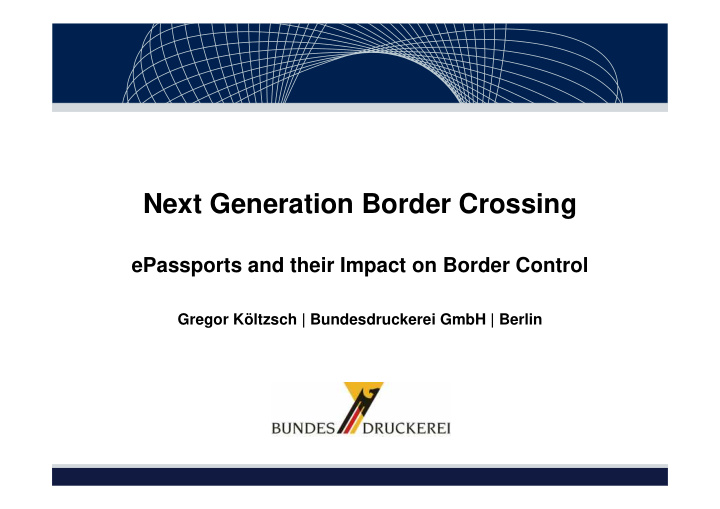



Next Generation Border Crossing ePassports and their Impact on Border Control Gregor Költzsch | Bundesdruckerei GmbH | Berlin
Contents � Trends � Status quo ePassports � Impact on border control � Future border control requirements and processes � Conclusion Gregor Költzsch – Bundesdruckerei – Berlin Page 2 3D Face
Trends with high impact on border control Mega trends � Globalization and growth in international travel � Terrorism, illegal migration, organized crime Subtrends � Integrated border management � New technologies � Integration of upstream processes � Risk profiling � Large-scale IT systems � Automation, self-service, and mobile control Gregor Költzsch – Bundesdruckerei – Berlin Page 3 3D Face
Status quo ePassports Electronic passports � Until 2010 approx. 43 countries will introduce ePassports � Most travellers will then have an electronic passport � ID cards with RFID and biometrics will be issued soon Others: � Visa Information System – VIS � Schengen Information System II – SIS II Gregor Költzsch – Bundesdruckerei – Berlin Page 4 3D Face
Interoperability Technical issues � MRTDs, chips and contactless interfaces are specified � Functional range and quality of the reading devices vary � Chip position and reader layout define reading process � Few initiatives regarding end devices � ePassport interoperability tests � Technical report on test standards for ePassports � No interoperability tests in future? Privacy issues � Privacy/security applications are not mandatory � BAC - Keys generated from MRZ � EAC – Key management and PKI structure required Gregor Költzsch – Bundesdruckerei – Berlin Page 5 3D Face
Extended Access Control (EAC) and PKI Supreme CA of the PKI Country Verifying � Issues document verifying certificates Certification Authority � Typically a sovereign task Manages doc reader certificates � Restricts access rights and the validity period Document Verifying CA Document Verifying CA � Issues inspection system certificates Document Readers Inspection Inspection Inspection Inspection � Access rights and access period system system system system defined by the IS certificates Gregor Költzsch – Bundesdruckerei – Berlin Page 6 3D Face
Challenges facing border control � Examination of people and ID Documents TD at checkpoints, green and blue border Many � Authentication, verification, identification Some Few No bio- 1 iden- 2 iden- 3 iden- metrics tifier tifiers tifiers No auto- Biometrics mation Today Low Medium Tomorrow High Level of automation Gregor Költzsch – Bundesdruckerei – Berlin Page 7 3D Face
Example: Automated forgery detection Border control point Automated MRZ detection � Basis for database queries Automated forgery detection � Embedded security features � Verification with reference database DB Gregor Költzsch – Bundesdruckerei – Berlin Page 8 3D Face
Example: Biometric verification Biometric verification Border control point � Fingerprint � Facial image � Appropriate environment conditions � SW, HW and integration � Maximum assistance for border control officers 1:1 VIS, 1:1 DB SIS II Gregor Költzsch – Bundesdruckerei – Berlin Page 9 3D Face
Example: Integration of upstream governmental processes Visa issuance � Pre-processing of data � All data available and accessible at the border control point � Biometric verification possible Secure Visa Issuance – Border Control System Border control retrieves Consulate captures and stores all relevant data including biometrics information from central database into a central database and conducts verification Potential � Speed up border clearing process � Close and secure chain between visa issuance and border control Gregor Költzsch – Bundesdruckerei – Berlin Page 10 3D Face
The primary inspection point Authentication Verification Identification MRZ reading, rarely forgery Visual Matching of MRZ data with Ongoing detection database procedures Future Data page ePassport vs. live data Matching of MRZ data with � Automated forgery detection database � Chip image vs. live image procedures � Different document databases � Chip finger vs. live finger (2 – 5 years) � Chip iris vs. live iris Biometric identification at secondary control Chip data � Validation of signatures ePassport vs. database � Integrity of data � Chip image vs. database image � Chip finger vs. database finger Data page matching chip � Facial image match � Biographic data match Visa vs. live characteristics � Database finger vs. live finger Additional documents � Visa � Registered traveller cards Gregor Költzsch – Bundesdruckerei – Berlin Page 11 3D Face
Staffed process document, Gregor Költzsch – Bundesdruckerei – Berlin Page 12 3D Face
Separated process document, Gregor Költzsch – Bundesdruckerei – Berlin Page 13 3D Face
Automated process MRTD officer Gregor Költzsch – Bundesdruckerei – Berlin Page 14 3D Face
Conclusion � Future border control will be based on ePassports � Interoperability depends on the capability of the supplier � Data collection and control will be moved upstream � Risk profiling and clustering of travellers for efficient allocation of resources � Data sharing, inter-agency cooperation, Integrated Border Management � Automation changes border control but does not substitute human work � New technologies enable secure and convenient border crossing Gregor Költzsch – Bundesdruckerei – Berlin Page 15 3D Face
Contact Bundesdruckerei GmbH Gregor Költzsch, MBA Oranienstrasse 91 | D-10958 Berlin Germany Phone: +49-30-25 98 - 3018 Fax: +49-30-25 98 - 1717 gregor.koeltzsch@bundesdruckerei.de www.bundesdruckerei.de Gregor Költzsch – Bundesdruckerei – Berlin Page 16 3D Face
Recommend
More recommend